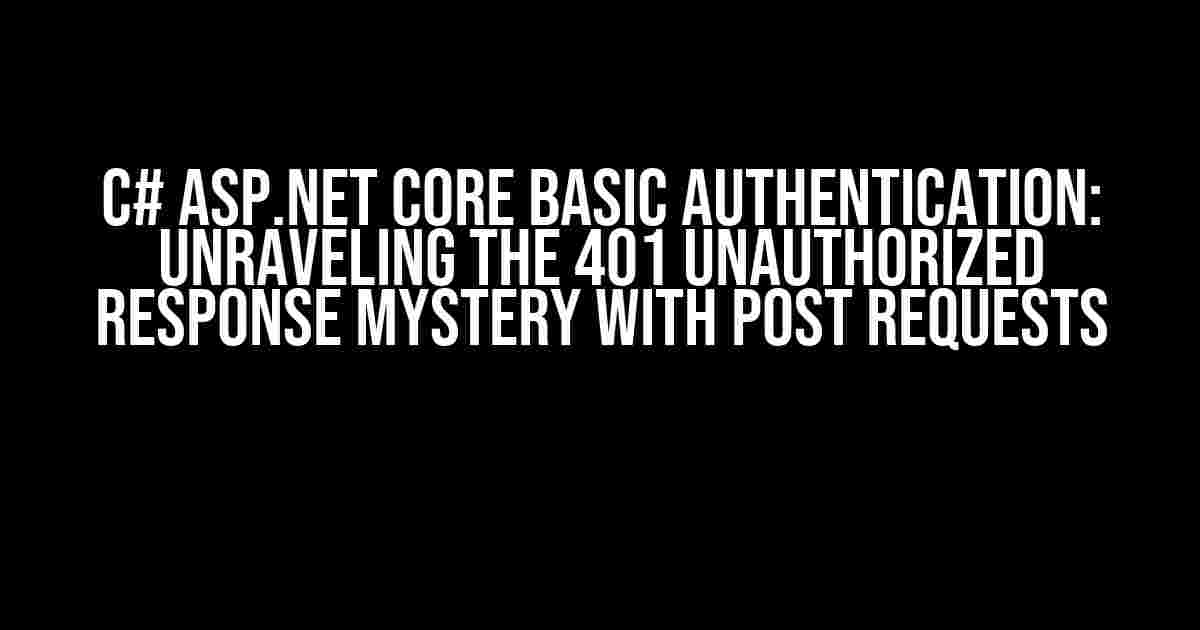Are you tired of encountering the frustrating 401 Unauthorized response when attempting to send a POST request with basic authentication in your C# ASP.NET Core application? You’re not alone! In this article, we’ll delve into the world of basic authentication, exploring the reasons behind this pesky error and providing a step-by-step guide to resolve it once and for all.
What is Basic Authentication?
Basic authentication is a simple authentication mechanism that involves sending a username and password as a string in the Authorization header of an HTTP request. This approach is often used for testing or development environments, as it doesn’t provide the same level of security as more advanced authentication methods like OAuth or JWT.
The 401 Unauthorized Response
When sending a POST request with basic authentication, you might encounter a 401 Unauthorized response, indicating that the server is refusing to authorize the request. But why does this happen? There are several reasons that might cause this error, including:
- Invalid or missing credentials
- Incorrectly formatted Authorization header
- Lack of authentication middleware in the ASP.NET Core pipeline
- Incorrectly configured authentication services
Step-by-Step Guide to Resolving the 401 Unauthorized Response
Let’s dive into the resolution process, and by the end of this article, you’ll be able to send POST requests with basic authentication like a pro!
Step 1: Install the Required NuGet Packages
In your ASP.NET Core project, make sure to install the following NuGet packages:
dotnet add package Microsoft.AspNetCore.Authentication.Basicdotnet add package Microsoft.AspNetCore.AuthorizationStep 2: Configure Authentication Services
In the `Startup.cs` file, add the following code to the `ConfigureServices` method:
public void ConfigureServices(IServiceCollection services)
{
services.AddAuthentication(BasicDefaults.AuthenticationScheme)
.AddBasic(options =>
{
options.Realm = "My Realm";
});
services.AddAuthorization(options =>
{
options.AddPolicy("BasicAuth", policy =>
{
policy.AddAuthenticationSchemes(BasicDefaults.AuthenticationScheme);
policy.RequireAuthenticatedUser();
});
});
services.AddControllers();
}Step 3: Configure the Authentication Middleware
In the `Startup.cs` file, add the following code to the `Configure` method:
public void Configure(IApplicationBuilder app, IWebHostEnvironment env)
{
app.UseRouting();
app.UseAuthentication();
app.UseAuthorization();
app.UseEndpoints(endpoints =>
{
endpoints.MapControllers();
});
}Step 4: Create a Basic Authentication Handler
Create a new class, e.g., `BasicAuthHandler.cs`, and add the following code:
public class BasicAuthHandler : AuthenticationHandler<AuthenticationSchemeOptions>
{
public BasicAuthHandler(IOptions<AuthenticationSchemeOptions> options, ILogger<AuthenticationHandler<AuthenticationSchemeOptions>> logger, UrlEncoder encoder, ISystemClock clock)
: base(options, logger, encoder, clock)
{
}
protected override Task<AuthenticateResult> HandleAuthenticateAsync()
{
var authHeaderValue = Request.Headers["Authorization"].FirstOrDefault();
if (authHeaderValue != null && authHeaderValue.StartsWith("Basic ", StringComparison.OrdinalIgnoreCase))
{
var usernameAndPassword = Encoding.UTF8.GetString(Convert.FromBase64String(authHeaderValue.Substring("Basic ".Length)));
var username = usernameAndPassword.Substring(0, usernameAndPassword.IndexOf(':'));
var password = usernameAndPassword.Substring(usernameAndPassword.IndexOf(':') + 1);
if (ValidateCredentials(username, password))
{
var claims = new[] { new Claim(ClaimTypes.Name, username) };
var identity = new ClaimsIdentity(claims, Scheme.Name);
var principal = new ClaimsPrincipal(identity);
return Task.FromResult(AuthenticateResult.Success(new AuthenticationTicket(principal, Scheme.Name)));
}
}
return Task.FromResult(AuthenticateResult.Fail("Invalid credentials"));
}
private bool ValidateCredentials(string username, string password)
{
// Implement your own credential validation logic here
return username == "admin" && password == "password";
}
}Step 5: Use the Basic Authentication Handler
In the `Startup.cs` file, update the `AddAuthentication` method to use the `BasicAuthHandler`:
services.AddAuthentication(BasicDefaults.AuthenticationScheme)
.AddBasic(options =>
{
options.Realm = "My Realm";
options.AuthenticationHandlerType = typeof(BasicAuthHandler);
});Step 6: Send the POST Request with Basic Authentication
Create a new instance of `HttpClient` and set the `Authorization` header with the basic authentication credentials:
var client = new HttpClient();
client.DefaultRequestHeaders.Authorization = new AuthenticationHeaderValue("Basic", Convert.ToBase64String(Encoding.ASCII.GetBytes("admin:password")));Now, you can send the POST request:
var request = new HttpRequestMessage(HttpMethod.Post, "https://localhost:5001/api/values");
request.Content = new StringContent("{\"name\":\"John Doe\"}", Encoding.UTF8, "application/json");
var response = await client.SendAsync(request);Troubleshooting Common Issues
While implementing basic authentication, you might encounter some common issues. Let’s address them:
Issue 1: Missing or Invalid Credentials
Double-check that you’re providing the correct username and password in the `Authorization` header. Make sure to encode the credentials using Base64.
Issue 2: Incorrectly Formatted Authorization Header
Verify that the `Authorization` header is correctly formatted, including the “Basic ” prefix, followed by a space, and then the Base64-encoded credentials.
Issue 3: Lack of Authentication Middleware
Ensure that you’ve added the authentication middleware in the `Startup.cs` file, as shown in Step 3.
Issue 4: Incorrectly Configured Authentication Services
Review the authentication services configuration in the `Startup.cs` file, making sure that you’ve added the necessary services and options.
Conclusion
You made it! With these steps, you should now be able to send POST requests with basic authentication in your C# ASP.NET Core application. Remember to implement your own credential validation logic in the `BasicAuthHandler` class, and don’t forget to troubleshoot common issues if you encounter any problems.
_basic authentication might not be the most secure method, but with this guide, you’ll be able to use it effectively in your development environment. Happy coding!
| Keyword | Description |
|---|---|
| C# | Programming language used for the example |
| ASP.NET Core | Web framework used for building the application |
| Basic Authentication | Authentication method used for sending credentials in the Authorization header |
| POST Request | HTTP request method used for sending data to the server |
| 401 Unauthorized Response | Error response code indicating that the request is unauthorized |
This article has provided a comprehensive guide to resolving the 401 Unauthorized response when sending POST requests with basic authentication in C# ASP.NET Core. By following the steps outlined above, you’ll be able to successfully implement basic authentication in your application.
Frequently Asked Questions
Get the answers to the most common questions about C# ASP.NET Core basic authentication POST getting 401 unauthorized response.
Why am I getting a 401 Unauthorized response when making a POST request with basic authentication in ASP.NET Core?
This is because the default behavior of ASP.NET Core is to challenge the authentication scheme when the request is unauthorized. You need to configure the authentication scheme to include the BasicAuthentication scheme and set the AuthenticationScheme property to “Basic” in the ConfigureServices method of the Startup.cs file.
How do I set up basic authentication in ASP.NET Core to allow POST requests?
To set up basic authentication in ASP.NET Core, you need to add the Authentication services in the ConfigureServices method and then add the Authentication middleware in the Configure method. You also need to create a custom authentication handler that inherits from AuthenticationHandler
What is the difference between AuthenticateAsync and ChallengeAsync in ASP.NET Core basic authentication?
AuthenticateAsync is used to authenticate the request using the specified authentication scheme, while ChallengeAsync is used to challenge the authentication scheme and return a 401 Unauthorized response if the request is not authenticated. In the context of basic authentication, AuthenticateAsync is used to verify the credentials, and ChallengeAsync is used to prompt the user for credentials.
How do I pass credentials in the POST request when using basic authentication in ASP.NET Core?
You can pass credentials in the Authorization header of the POST request using the format “Basic
Why do I need to use HTTPS when using basic authentication in ASP.NET Core?
Basic authentication sends the username and password in plain text, which can be intercepted by an attacker. Using HTTPS encrypts the communication between the client and server, making it more secure. It’s highly recommended to use HTTPS when using basic authentication to protect sensitive information.




